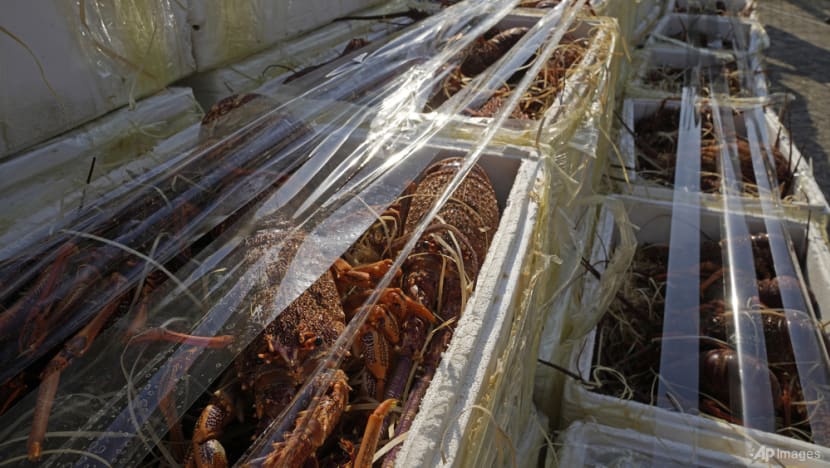Sustainable lobster fishing, fish leather part of Australia’s green push in seafood industry
Unsustainable fishing practices pose a threat to both food security and livelihoods in countries around the world, according to the United Nations.

WESTERN AUSTRALIA: Fishermen in Australia’s largest state are taking innovative steps to boost the sustainability of their industry.
The United Nations has warned that failure to undertake sustainable fishing management measures threatens food security and livelihoods in countries around the world.
In Western Australia, industry players are recycling their waste products such as by producing fish leather, and also ensuring their catches are made through methods that do not damage the environment or deplete a species.
Thought has also gone into an export plan that prioritises Australian seafood, moving it away from a reliance on the China market.
REUSING FISH WASTE
To tackle the problem of fish waste, one business is revitalising the ancient craft of creating fish leather.
Mermaid Leather is the only fish leather company in Australia. Owner David McDermott said the driving factor for the business from the beginning was sustainability in the fishery industry.
The idea came to his brother Andrew and his friend Bob Bubb, both of whom have passed on, almost 30 years ago while they were working in the fishing industry.
"Bob owned and operated his own commercial fishing boat and he … saw the amount of waste being generated by his fishing boat,” he said, adding that it took them four years to develop a strong quality fish leather.

Mr McDermott pays commercial fisheries US$0.34 per kilogram for the fish skin, which typically either end up back in the ocean or straight into a landfill.
It takes four weeks to remove the scales, put the skins in a drum to be pickled, tanned, dried, coloured and eventually turn them into wallets, handbags and clothes – some that have even appeared in the New York fashion scene.
The shop also serves as an education centre for tourists.
"It's about educating the next generation in sustainable practices (and) looking at products that we can use and that are normally perceived as waste,” said Mr McDermott.
REPLACING FISH CAUGHT
According to the Minderoo Foundations Global Fishing Index, overfishing has left a tenth of the world’s fishing population on the brink of collapse.
Some companies in Western Australia have worked for years to restore depleted fish stocks and find ways to halt overfishing, in a region where the activity is part of its cultural identity.
Fisherman Carmelo Mendolia, who has been a professional lobster fisherman for 47 years, said attitudes have changed for the better. Instead of fishing until the supply of lobsters runs dry, there is now a specific sustainable plan in place.
"We are on a quota, so we only take a certain amount of crays every year that keeps us sustainable. Fishermen want to be sustainable because it’s our livelihood,” said Mr Mendolia.
It’s a strategy that other fisheries across the country, including western rock lobster fishermen, are trying to adopt.
Things like how much bait and fuel are used are closely monitored, along with yearly catch and size limits in place.
The lobsters are also caught in pots, which has minimal impact on the marine environment compared to bottom trawling, a method that drags large nets across the sea floor.
Fish heads that are typically thrown away, are now used as bait in lobster crates.
The Western Rock Lobster Council this year celebrated its fifth Marine Stewardship Council accreditation, a world-renowned sustainability certification programme that ensures fisheries are following best practices when it comes to the environment.
The council’s chief executive officer Matt Taylor said: "We actually pay a fair bit of money each year to undertake an audit. So we get an independent auditor to come in and assess the fishery. It's particularly onerous. We invest in and work in collaboration with the government to make sure that the resource is sustainably managed."
NEW MARKETS
Australia’s seafood industry is aiming to ensure its survival in the face of freight constraints and Chinese sanctions, setting itself up for a post-pandemic rebound with new trading partners.
Mr Matt Rutter, chief executive officer of Geraldton Fishermen’s Co-Operative, the largest rock lobster exporter in the world, said: "Before the pandemic ... over 90 per cent of our product was going into China and that's simply because they revere the products so much."
The company was pushed to breaking point when the COVID-19 pandemic hit, due to the dual blow of freight constraints and China’s sanctions.
With a major export market cut off, domestic oversupply has brought prices down to around US$25 per kilogram, from the premium price of at least US$53.
"When China shut down, that was when our market shut down for two months. Part of what we've done the last two and a half years is make sure that we have diversified the supply chain,” he said, adding that the firm is now entering Asian markets, including Japan, Taiwan, Korea, Singapore, Hong Kong and the Philippines.
While their revenue is still half of what it was pre-pandemic, this diversification has allowed them to keep operating.

A strategic plan, backed by the Australian federal government, aims to future-proof the supply and boost exports of the country’s seafood industry to some US$1.4 billion by 2030.
Ms Veronica Papacosta, chief executive officer of Seafood Industry Australia, said: "We are obviously looking to make sure that we are servicing lots of Asian markets, and making sure Australian seafood groups use as many channels as we can, which is one of our learnings through COVID."
There has also been a shift towards locally caught products, which is now a key supplier of local businesses.
Mr Phil Clark, co-owner of Fins Seafood, said the pandemic saw a rise in local demand for their products. A lot of revenue now comes from the hospitality sector, including fancy restaurants in the wine region of Margaret River.
"Customers are very aware of what fish species they should be eating, or what fisheries they shouldn't be eating. So they are very well educated now than, say, maybe 10 years ago,” said Frui Momento head chef Seth James.














